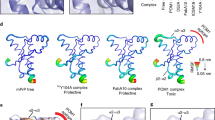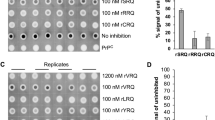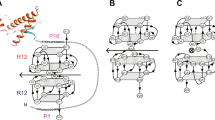Abstract
Transmissible spongiform encephalopathies (TSEs) are fatal neurodegenerative diseases that lack therapeutic solutions. Here, we show that the molecular chaperone (N,N′-([cyclohexylmethylene]di-4,1-phenylene)bis(2-[1-pyrrolidinyl]acetamide)), designed via docking simulations, molecular dynamics simulations and quantum chemical calculations, slows down the progress of TSEs. In vitro, the designer molecular chaperone stabilizes the normal cellular prion protein, eradicates prions in infected cells, prevents the formation of drug-resistant strains and directly inhibits the interaction between prions and abnormal aggregates, as shown via real-time quaking-induced conversion and in vitro conversion NMR. Weekly intraperitoneal injection of the chaperone in prion-infected mice prolonged their survival, and weekly intravenous administration of the compound in macaques infected with bovine TSE slowed down the development of neurological and psychological symptoms and reduced the concentration of disease-associated biomarkers in the animals’ cerebrospinal fluid. The de novo rational design of chaperone compounds could lead to therapeutics that can bind to different prion protein strains to ameliorate the pathology of TSEs.
This is a preview of subscription content, access via your institution
Access options
Access Nature and 54 other Nature Portfolio journals
Get Nature+, our best-value online-access subscription
$29.99 / 30 days
cancel any time
Subscribe to this journal
Receive 12 digital issues and online access to articles
$99.00 per year
only $8.25 per issue
Buy this article
- Purchase on Springer Link
- Instant access to full article PDF
Prices may be subject to local taxes which are calculated during checkout







Similar content being viewed by others
Code availability
The PAICS codes are available at www.paics.net/index_e.html.
Data availability
The authors declare that all data supporting the findings of this study are available within the paper and its Supplementary Information.
References
Prusiner, S. B. Novel proteinaceous infectious particles cause scrapie. Science 216, 136–144 (1982).
Prusiner, S. B. Prions. Proc. Natl Acad. Sci. USA 95, 13363–13383 (1998).
Safar, J. et al. Eight prion strains have PrPSc molecules with different conformations. Nat. Med. 4, 1157–1165 (1998).
Huang, Y., Gregori, L., Anderson, S. A., Asher, D. M. & Yang, H. Development of dose–response models of Creutzfeldt–Jakob disease infection in nonhuman primates for assessing the risk of transfusion-transmitted variant Creutzfeldt–Jakob disease. J. Virol. 88, 13732–13736 (2014).
Vazquez-Fernandez, E. et al. The structural architecture of an infectious mammalian prion using electron cryomicroscopy. PLoS Pathog. 12, e1005835 (2016).
Groveman, B. R. et al. Parallel in-register intermolecular beta-sheet architectures for prion-seeded prion protein (PrP) amyloids. J. Biol. Chem. 289, 24129–24142 (2014).
Govaerts, C., Wille, H., Prusiner, S. B. & Cohen, F. E. Evidence for assembly of prions with left-handed beta-helices into trimers. Proc. Natl Acad. Sci. USA 101, 8342–8347 (2004).
Anfinsen, C. B. Principles that govern the folding of protein chains. Science 181, 223–230 (1973).
Kabir, A. et al. Effects of ligand binding on the stability of aldo-keto reductases: implications for stabilizer or destabilizer chaperones. Protein Sci. 25, 2132–2141 (2016).
Uchiyama, K. et al. Prions amplify through degradation of the VPS10P sorting receptor sortilin. PLoS Pathog. 13, e1006470 (2017).
Berry, D. B. et al. Drug resistance confounding prion therapeutics. Proc. Natl Acad. Sci. USA 110, E4160–E4169 (2013).
Giles, K. et al. Optimization of aryl amides that extend survival in prion-infected mice. J. Pharmacol. Exp. Ther. 358, 537–547 (2016).
Ma, B., Yamaguchi, K., Fukuoka, M. & Kuwata, K. Logical design of anti-prion agents using NAGARA. Biochem. Biophys. Res. Commun. 469, 930–935 (2016).
Kuwata, K. Logical design of medical chaperone for prion diseases. Curr. Top. Med. Chem. 13, 2432–2440 (2013).
Kuwata, K. et al. Hot spots in prion protein for pathogenic conversion. Proc. Natl Acad. Sci. USA 104, 11921–11926 (2007).
Ishikawa, T., Ishikura, T. & Kuwata, K. Theoretical study of the prion protein based on the fragment molecular orbital method. J. Comput. Chem. 30, 2594–2601 (2009).
Milhavet, O. et al. Prion infection impairs the cellular response to oxidative stress. Proc. Natl Acad. Sci. USA 97, 13937–13942 (2000).
Kimura, T., Hosokawa-Muto, J., Kamatari, Y. O. & Kuwata, K. Synthesis of GN8 derivatives and evaluation of their antiprion activity in TSE-infected cells. Bioorg. Med. Chem. Lett. 21, 1502–1507 (2011).
Atarashi, R. et al. Ultrasensitive human prion detection in cerebrospinal fluid by real-time quaking-induced conversion. Nat. Med. 17, 175–178 (2011).
Saborio, G. P., Permanne, B. & Soto, C. Sensitive detection of pathological prion protein by cyclic amplification of protein misfolding. Nature 411, 810–813 (2001).
Miller, M. B. et al. Cofactor molecules induce structural transformation during infectious prion formation. Structure 21, 2061–2068 (2013).
Riek, R. et al. NMR structure of the mouse prion protein domain PrP(121-231). Nature 382, 180–182 (1996).
Singh, J. & Udgaonkar, J. B. The pathogenic mutation T182A converts the prion protein into a molten globule-like conformation whose misfolding to oligomers but not to fibrils is drastically accelerated. Biochemistry 55, 459–469 (2016).
Yamamoto, N. & Kuwata, K. Regulating the conformation of prion protein through ligand binding. J. Phys. Chem. B 113, 12853–12856 (2009).
Singh, J. & Udgaonkar, J. B. Structural effects of multiple pathogenic mutations suggest a model for the initiation of misfolding of the prion protein. Angew. Chem. Int. Ed. Engl. 54, 7529–7533 (2015).
Honda, R. P., Xu, M., Yamaguchi, K., Roder, H. & Kuwata, K. A native-like intermediate serves as a branching point between the folding and aggregation pathways of the mouse prion protein. Structure 23, 1735–1742 (2015).
Sugase, K., Dyson, H. J. & Wright, P. E. Mechanism of coupled folding and binding of an intrinsically disordered protein. Nature 447, 1021–1025 (2007).
Malevanets, A. et al. Interplay of buried histidine protonation and protein stability in prion misfolding. Sci. Rep. 7, 882 (2017).
Kamatari, Y. O., Hayano, Y., Yamaguchi, K., Hosokawa-Muto, J. & Kuwata, K. Characterizing antiprion compounds based on their binding properties to prion proteins: implications as medical chaperones. Protein Sci. 22, 22–34 (2013).
Gatti, J. L. et al. Prion protein is secreted in soluble forms in the epididymal fluid and proteolytically processed and transported in seminal plasma. Biol. Reprod. 67, 393–400 (2002).
Peralta, O. A. & Eyestone, W. H. Quantitative and qualitative analysis of cellular prion protein (PrPC) expression in bovine somatic tissues. Prion 3, 161–170 (2009).
Ono, F. et al. Experimental transmission of bovine spongiform encephalopathy (BSE) to cynomolgus macaques, a non-human primate. Jpn. J. Infect. Dis. 64, 50–54 (2011).
Orru, C. D. et al. Rapid and sensitive RT-QuIC detection of human Creutzfeldt–Jakob disease using cerebrospinal fluid. mBio 6, e02451-14 (2015).
International Conference on Harmonisation of Technical Requirements for Registration of Pharmaceuticals for Human Use (ICH) adopts consolidated guideline on good clinical practice in the conduct of clinical trials on medicinal products for human use. Int. Dig. Health Legis. 48, 231–234 (1997).
Mead, S. et al. PRION-1 scales analysis supports use of functional outcome measures in prion disease. Neurology 77, 1674–1683 (2011).
Matsui, Y. et al. High sensitivity of an ELISA kit for detection of the gamma-isoform of 14-3-3 proteins: usefulness in laboratory diagnosis of human prion disease. BMC. Neurol. 11, 120 (2011).
Kawasaki, Y. et al. Orally administered amyloidophilic compound is effective in prolonging the incubation periods of animals cerebrally infected with prion diseases in a prion strain-dependent manner. J. Virol. 81, 12889–12898 (2007).
Lysek, D. A. et al. Prion protein NMR structures of cats, dogs, pigs, and sheep. Proc. Natl Acad. Sci. USA 102, 640–645 (2005).
Nicoll, A. J. et al. Pharmacological chaperone for the structured domain of human prion protein. Proc. Natl Acad. Sci. USA 107, 17610–17615 (2010).
Massignan, T. et al. A cationic tetrapyrrole inhibits toxic activities of the cellular prion protein. Sci. Rep. 6, 23180 (2016).
Zahn, R. et al. NMR solution structure of the human prion protein. Proc. Natl Acad. Sci. USA 97, 145–150 (2000).
Gossert, A. D., Bonjour, S., Lysek, D. A., Fiorito, F. & Wuthrich, K. Prion protein NMR structures of elk and of mouse/elk hybrids. Proc. Natl Acad. Sci. USA 102, 646–650 (2005).
Garcia, F. L., Zahn, R., Riek, R. & Wuthrich, K. NMR structure of the bovine prion protein. Proc. Natl Acad. Sci. USA 97, 8334–8339 (2000).
Calzolai, L., Lysek, D. A., Perez, D. R., Guntert, P. & Wuthrich, K. Prion protein NMR structures of chickens, turtles, and frogs. Proc. Natl Acad. Sci. USA 102, 651–655 (2005).
Oelschlegel, A. M. & Weissmann, C. Acquisition of drug resistance and dependence by prions. PLoS Pathog. 9, e1003158 (2013).
Ghaemmaghami, S. et al. Continuous quinacrine treatment results in the formation of drug-resistant prions. PLoS Pathog. 5, e1000673 (2009).
Demaimay, R. et al. Late treatment with polyene antibiotics can prolong the survival time of scrapie-infected animals. J. Virol. 71, 9685–9689 (1997).
Lee, W., Tonelli, M. & Markley, J. L. NMRFAM-SPARKY: enhanced software for biomolecular NMR spectroscopy. Bioinformatics 31, 1325–1327 (2015).
Delano, W. L. Use of PyMOL as a communications tool for molecular science. Abstr. Pap. Am. Chem. Soc. 228, U313–U314 (2004).
Kitaura, K., Ikeo, E., Asada, T., Nakano, T. & Uebayasi, M. Fragment molecular orbital method: an approximate computational method for large molecules. Chem. Phys. Lett. 313, 701–706 (1999).
Ishikawa, T. & Kuwata, K. Fragment molecular orbital calculation using the RI-MP2 method. Chem. Phys. Lett. 474, 195–198 (2009).
Kay, L. E., Torchia, D. A. & Bax, A. Backbone dynamics of proteins as studied by 15N inverse detected heteronuclear NMR spectroscopy: application to staphylococcal nuclease. Biochemistry 28, 8972–8979 (1989).
Nishida, N. et al. Successful transmission of three mouse-adapted scrapie strains to murine neuroblastoma cell lines overexpressing wild-type mouse prion protein. J. Virol. 74, 320–325 (2000).
Hosokawa-Muto, J., Kamatari, Y. O., Nakamura, H. K. & Kuwata, K. Variety of antiprion compounds discovered through an in silico screen based on cellular-form prion protein structure: correlation between antiprion activity and binding affinity. Antimicrob. Agents Chemother. 53, 765–771 (2009).
Thompson, A. G. et al. The Medical Research Council prion disease rating scale: a new outcome measure for prion disease therapeutic trials developed and validated using systematic observational studies. Brain 136, 1116–1127 (2013).
Muramatsu, S. et al. Behavioral recovery in a primate model of Parkinson’s disease by triple transduction of striatal cells with adeno-associated viral vectors expressing dopamine-synthesizing enzymes. Hum. Gene Ther. 13, 345–354 (2002).
R Development Core Team R: A Language and Environment for Statistical Computing (R Foundation for Statistical Computing, 2014).
Takahashi, H. et al. Characterization of antibodies raised against bovine-PrP-peptides. J. Neurovirol. 5, 300–307 (1999).
Meredith, J. E. Jr et al. Characterization of novel CSF Tau and ptau biomarkers for Alzheimer’s disease. PLoS ONE 8, e76523 (2013).
Acknowledgements
We thank M. Fukushima at the Translational Research Informatics Center and H. Mizusawa at the National Center of Neurology and Psychiatry for fruitful discussion. We also thank R. Honda, T. Saeki, M. Horii and S. Hori for providing technical help. K.K. was supported in part by a Grant-in-Aid for Scientific Research from the Ministry of Education, Culture, Sports, Science and Technology of Japan, and by grants from the Ministry of Health, Labour and Welfare. The study was also supported by a grant from the Practical Research Project for Rare/Intractable Diseases of the Japan Agency for Medical Research and Development.
Author information
Authors and Affiliations
Contributions
K.Y. prepared the 15N-labelled and non-labelled recombinant prions, and performed the IVC-NMR measurements and analysis. Y.O.K. measured and analysed the binding data using NMR and SPR. F.O. and H.S. conducted the in vivo treatment study. D.I. and M.T. conducted the pathological examinations for mice and macaques, respectively. T.F. and N.N. analysed Tau proteins in the central nervous system. T.K. established the method for the synthesis of the anti-prion compounds. J.H-M., A.E.E. and M.F. performed the in vitro, ex vivo and in vivo experiments. T.I. coded the FMO programme PAICS using the programming language C. Y.T. and Y.M. performed the statistical analysis. K.K. supervised the project, analysed the data and wrote the manuscript.
Corresponding author
Ethics declarations
Competing interests
The authors declare no conflicts of interest.
Additional information
Publisher’s note: Springer Nature remains neutral with regard to jurisdictional claims in published maps and institutional affiliations.
Supplementary information
Supplementary Information
Supplementary figures and tables.
Supplementary Video 1
Prion infected macaque (number 6, control) at 19.7 m.p.i.
Supplementary Video 2
Prion infected macaque (number 3, BOS) at 19.7 m.p.i.
Rights and permissions
About this article
Cite this article
Yamaguchi, K., Kamatari, Y.O., Ono, F. et al. A designer molecular chaperone against transmissible spongiform encephalopathy slows disease progression in mice and macaques. Nat Biomed Eng 3, 206–219 (2019). https://doi.org/10.1038/s41551-019-0349-8
Received:
Accepted:
Published:
Issue Date:
DOI: https://doi.org/10.1038/s41551-019-0349-8
This article is cited by
-
Therapeutic strategies for identifying small molecules against prion diseases
Cell and Tissue Research (2023)
-
Hampering the early aggregation of PrP-E200K protein by charge-based inhibitors: a computational study
Journal of Computer-Aided Molecular Design (2021)
-
Development and structural determination of an anti-PrPC aptamer that blocks pathological conformational conversion of prion protein
Scientific Reports (2020)
-
Novel Compounds Identified by Structure-Based Prion Disease Drug Discovery Using In Silico Screening Delay the Progression of an Illness in Prion-Infected Mice
Neurotherapeutics (2020)
-
A designer chaperone against prion diseases
Nature Biomedical Engineering (2019)



